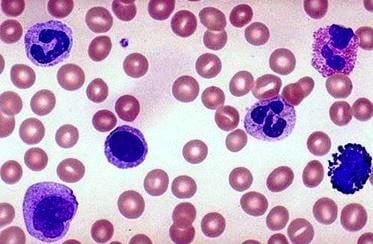High Monocytes Count
Monocytes Description
WBC contains five major types of cells and according to their appearance; they are divided into two groups – Granulocytes and Agranulocytes. Granulocytes are Eosinophils, Neutrophils and Basophils. Agranulocytes are Lymphocytes and Monocytes. These five types of WBCs are part of our immune system and provide defensive mechanism towards our body. Their functionality differs from each other.

Blood Smear Showing High Monocyte count
Monocytes are having single, large, smooth, identifiable, bean shaped nuclease at their centre. Monocytes can change their shape according to the need of immunity activation. The major functions of monocytes are assisting other WBCs, eliminate unessential tissue debris or dead tissues, obliterate malignant cells and control our immunity system against invaded foreign cells. Monocytes are manufactured in bone marrow and then go to circulatory system. Monocytes then travel to different organs which include spleen, lungs, liver, bone marrow and where they become matured and changed their shape to macrophages.
Monocytes play versatile role in immune system. They convert to macrophages when any virus, bacteria, parasites or any foreign particles invade our body. Macrophages engulf them and acts as scavenger cells. They also break down all the tissue debris and able to destroy infected cells by special types of enzyme which is produces in the macrophages. Once foreign particles enter into the body, macrophages prepares antigen which signals that these are the harmful substances for body. After identification of antigen, our immune system prepare antibody against them. In future, identified invaders or antigen gets coated with antibody and are easily recognisable by macrophages and they destroy them by phagocytosis. Phagocytosis is a direct engulfing process that utilizes the enzyme through macrophages. Antibody is a proteinous substance which has antigen specific action. When any infection occurs, inflammation is a common symptom because of complement.
Complement is protein in nature and provides inflammation and monocytes catch the inflammation signal and reach into the affected tissue. After that monocytes convert into macrophages and dendritic cells that help to develop further immunity against invaders and destroy them. Dendritic cells are another form of monocytes, unlike macrophages they not directly engulf the invaders but represent them in front of T-cells and B cells. T-cells and B cells are special types of WBCs. They help to recognise antigen and provide immunity against these foreign substances. Dendritic cells also take part in wound healing.
Monocytes also produce interleukins-1, interlukins-2 and tumour necrosis factors. These are cytokines which can produce inflammation during activation of monocytes; this mechanism is help full in laboratory research. Cytokines also help to interacting with other WBCs.
Monocytes hold fine chromatins which help in formation of chromosomes. Chromosomes develop individual gene structure that contains specific DNA. Evidence shows that monocytes are also take part in vital organs formation which includes brain and heart.
What % of WBC are Monocytes?
Among total circulating WBCs, the percentage of monocytes is 1 to 10 % i.e. per microliter of blood the amount of monocytes are two hundred to six hundred. 2-8% monocytes are approximately present in total WBC’s count. Total leucocytes count (TLC) provides the amount of WBCs in circulating blood and differential leukocytes count helps to spot the different types of WBCs.
Presence of Monocytes
After reaching in the circulation monocytes stayed with blood component for one to three days and then travel to different organs like spleen, lungs, liver and bone marrow for conversion of macrophages. Macrophages are then available almost all vital organ which include brain, spinal cord, bones, liver and in immune system. The different forms of macrophages are Kupffer cells, microglia, histiocytes and osteoclasts and their availability differ from organs.
Causes of High Monocytes Count
Clinically high monocytes count is termed as monocytosis. Monocytosis is aggravated with increased stress level. Other abnormality in physiological condition includes inflammation, viral infection (measles and mumps), severe bacterial infection (pneumonia), parasitic infection, increased cell fatality, malfunction in immune system, and resurrection of RBCs (Red Blood Cells). The disease conditions that cause high monocyte count are:
- Sarcoidos (unusual tiny, circular shaped bumps formation on the surface of the affected tissues)
- Chronic granulomatous disease (genetic disorder where immune system cells can not destroy specific types of bacteria, fungus etc.)
- Cushing’s syndrome (excess secretion of steroidal hormone like cortisol from adrenal gland)
- Langerhans cell histiocytosis (is a disease in which cells called histiocytes multiply in the Langerhans cells of pancreas, often causing wound).
Treatment of High Monocytes Count
For treating monocytosis, it is important to diagnose the underlying cause. It is always advisable to consult your doctor who is the right person to identify the abnormal condition and help to resolve the abnormality.
Changes in lifestyle such as regular exercise, weight management and adequate sleep help to control the monocytes count. Some proper food intake and diet supplements consumption can help to augment the treatment process and can regulate high monocytes level.
Food Items
Food that contains high antioxidant property can help to boost immunity and reduce the incidence of infection. The list of food items and spices which have antioxidant property and can reduce inflammation are:
- Spinach
- Onion
- Garlic
- Turmeric
- Black cumin
- Grapes
- Cherries
- Broccoli
- Beans
Diet Supplements
Omega -3 fatty acids supplements includeing fish liver oil supplements, curcumin supplements help to reduce the inflammation.
References
- http://www.medfriendly.com/monocyte.html
- https://www.merckmanuals.com/home/blood-disorders/white-blood-cell-disorders/monocyte-disorders
- http://study.com/academy/lesson/what-are-monocytes-definition-function-blood-test.html
- http://www.diagnose-me.com/symptoms-of/monocytes-elevated.html
- http://www.bloodtestresultsdecoded.com/deliverables/btrd-AbnormalResults.pdf
